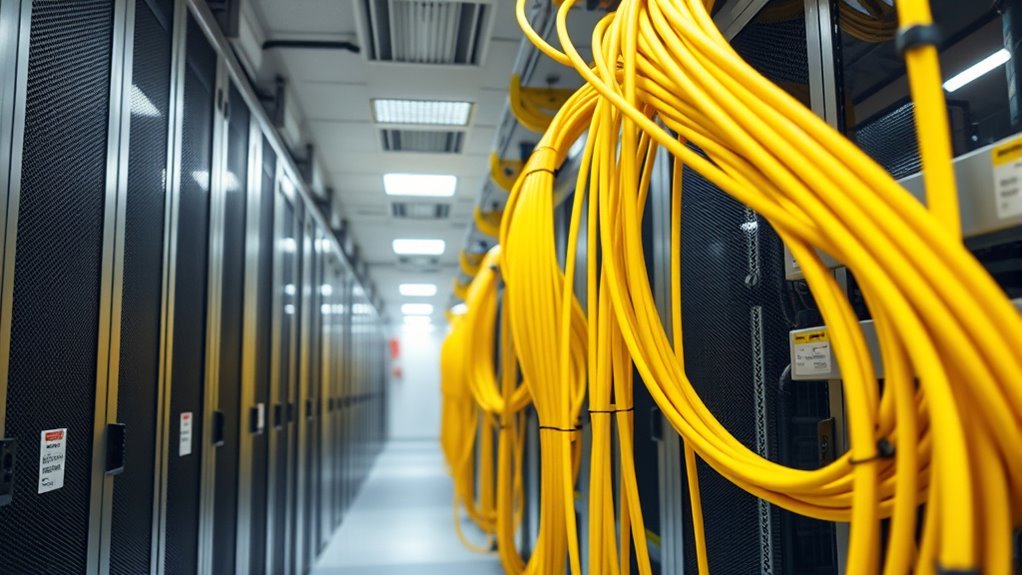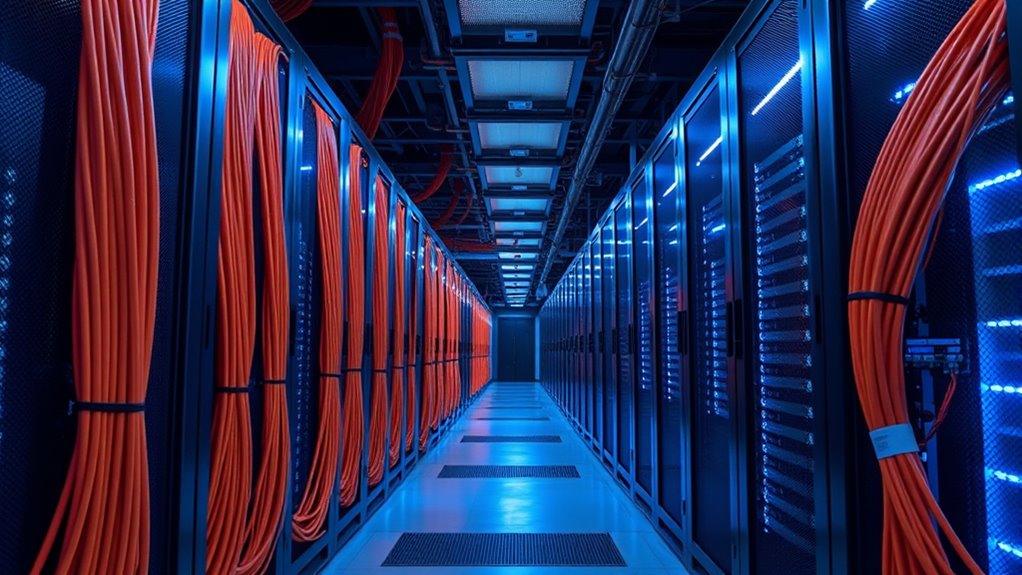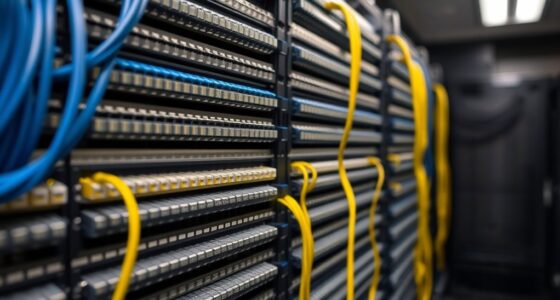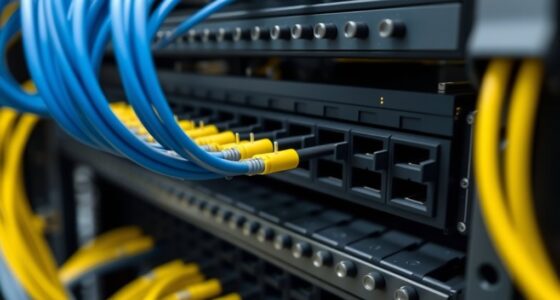Fire safety in data centers often feels like an ongoing challenge, yet many overlook the critical role of cable materials in prevention. While high-performance equipment is essential, the cables connecting your systems can be a hidden risk if not properly selected and managed. LSZH cables offer a safer alternative by emitting minimal smoke and no halogen gases during a fire, but are you fully aware of their benefits and how they integrate into your safety plan?
Key Takeaways
- LSZH cables emit minimal smoke and no halogen gases, reducing toxic fumes during a fire in data centers.
- Proper verification of cable insulation ensures compliance with safety standards and enhances fire safety.
- Regular inspection and maintenance of cables prevent insulation degradation, lowering fire risk.
- Integrating LSZH cables with effective fire detection and suppression systems improves overall safety.
- Using fire-resistant cable materials and adhering to safety protocols creates a layered defense in data center fire safety.

Fire safety is a critical concern in data centers, where the dense concentration of sensitive equipment makes any fire incident potentially disastrous. One of the key elements in preventing the spread of fire is the choice of cable insulation. Traditional cables often use materials that can produce toxic smoke or support flame propagation when exposed to heat. In contrast, LSZH (Low Smoke Zero Halogen) cables are designed to emit minimal smoke and no halogen gases if they catch fire. This characteristic markedly reduces the risk of toxic fumes, which can impair evacuation efforts and harm personnel. When installing cables, you need to verify that their insulation materials meet safety standards for fire resistance and smoke emission. Proper cable management, including securing cables properly and avoiding overloading conduits, also minimizes the risk of electrical faults that could ignite a fire.
Along with selecting the right cables, implementing robust emergency protocols is crucial. These protocols should outline clear steps for evacuation, fire suppression, and communication during an incident. As someone responsible for data center safety, you must verify all staff are trained to recognize fire hazards and respond quickly. Regular drills can help familiarize everyone with emergency procedures, reducing panic and confusion during actual emergencies. Emergency protocols should also specify the use of fire detection and suppression systems that are compatible with the environment, such as clean agent or inert gas systems that won’t damage sensitive equipment. Integrating LSZH cables into your infrastructure supports these protocols by providing a safer environment, as they produce less smoke and toxic gases if a fire occurs, giving occupants more time to evacuate safely. Additionally, the use of fire-resistant materials in cable design further enhances safety by reducing the likelihood of ignition and slowing fire spread.
Furthermore, your maintenance routines should include regular inspections of cable insulation integrity and fire detection systems. Damaged or degraded cable insulation can increase fire risk, so promptly replacing compromised cables is critical. Also, ensure fire alarm systems and emergency exit signage are always functional and visible. By maintaining a proactive approach to fire safety and understanding the importance of cable insulation, you can considerably reduce the potential for a catastrophic fire. Combining the use of LSZH cables with comprehensive emergency protocols forms a layered defense, protecting personnel, equipment, and data integrity. Your vigilance and adherence to safety standards are essential in creating a resilient data center environment where risks are minimized, and quick, effective responses are in place should an incident occur.
Frequently Asked Questions
How Do LSZH Cables Compare Cost-Wise to Standard Cables?
LSZH cables generally cost more upfront than standard cables, but their cost comparison depends on your budget considerations. While they may seem pricier initially, they offer significant safety benefits that can reduce long-term expenses, especially in sensitive environments. You’ll want to weigh the higher initial investment against the safety and compliance advantages they provide, making LSZH cables a cost-effective choice when safety is a priority.
Are LSZH Cables Suitable for Outdoor Data Center Applications?
You get what you pay for, and LSZH cables are indeed suitable for outdoor data center applications. They offer excellent outdoor durability and UV resistance, ensuring they withstand harsh weather conditions. While they may cost a bit more upfront, their resilience and safety benefits make them a smart choice. Trust in LSZH cables for outdoor use, because protecting your infrastructure is always worth the investment.
What Are the Environmental Impacts of LSZH Cable Production?
You should know that LSZH cable production impacts the environment through manufacturing emissions and toxic chemical use. During manufacturing, emissions release greenhouse gases and pollutants into the air, contributing to climate change. Additionally, toxic chemicals are often used in insulation and sheathing, which can harm ecosystems and pose health risks if not properly managed. Reducing these impacts requires adopting cleaner production methods and sustainable materials.
How Often Should LSZH Cables Be Inspected for Fire Safety?
You should inspect LSZH cables regularly, ideally every 6 to 12 months, to guarantee fire safety protocols are maintained. Frequent inspections help identify any damage, wear, or degradation that could compromise fire safety. Always follow your organization’s specific inspection schedule and protocols, and document each check. Regular inspections are vital for early detection of issues, ensuring the cables remain safe and compliant with fire safety standards.
Can LSZH Cables Be Recycled Easily After Use?
You can recycle LSZH cables, but recycling challenges exist due to their complex materials and coatings. These challenges make separation and proper processing difficult, limiting easy recycling options. However, choosing LSZH cables offers environmental benefits by reducing toxic emissions during fires and decreasing hazardous waste. To maximize sustainability, you should work with specialized recycling facilities that handle these cables properly, helping you minimize environmental impact despite the recycling challenges.
Conclusion
By choosing LSZH cables, you considerably reduce fire hazards in your data center—studies show they emit up to 90% less smoke than conventional cables. This not only enhances safety but also improves evacuation times and minimizes toxic exposure. When combined with proper cable management and safety protocols, LSZH cables help create a resilient environment. Prioritizing these measures ensures your data center stays protected, keeping personnel safe and data secure in the face of fire risks.









